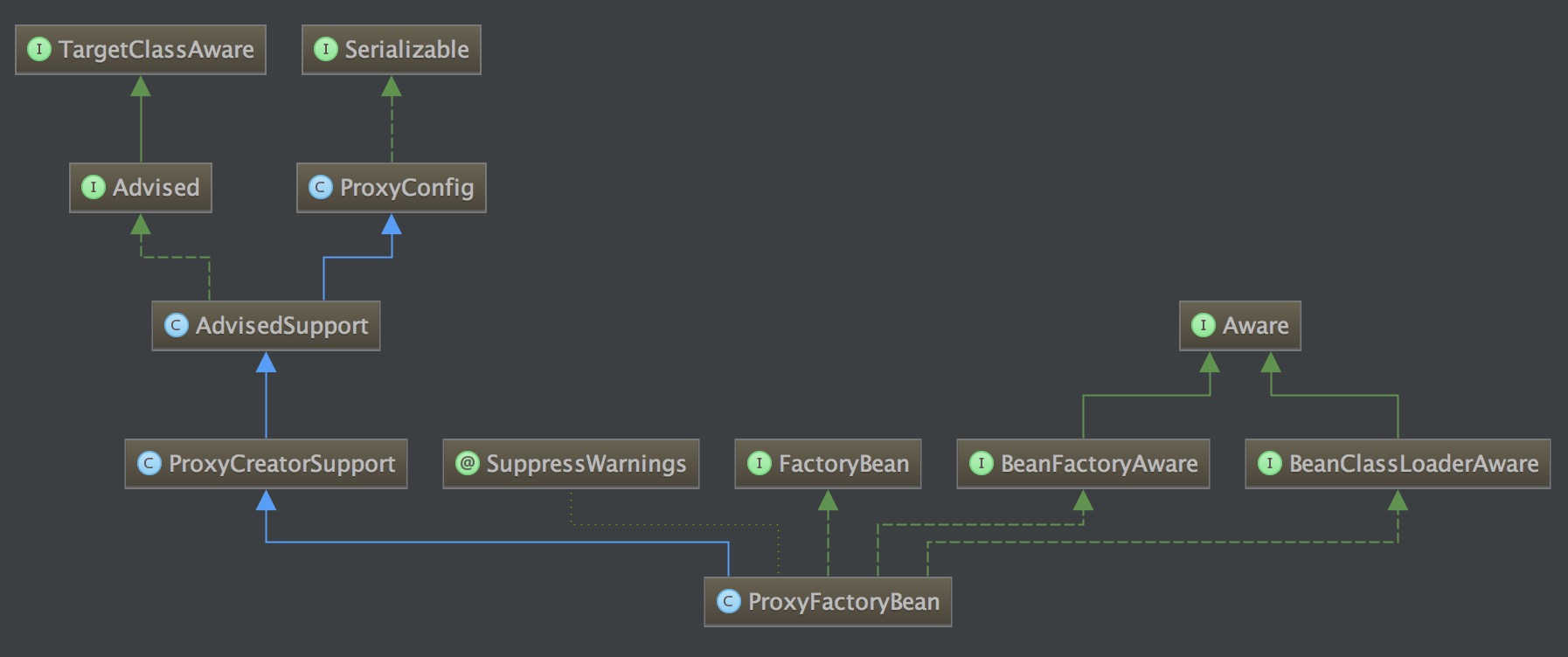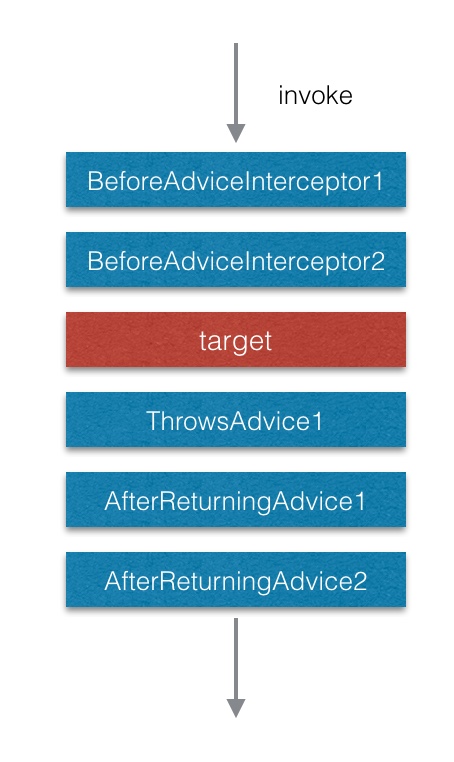AOP执行增强-Spring 源码系列(5)
AOP增强实现-Spring 源码系列(5)
目录:
Ioc容器beanDefinition-Spring 源码(1)
Ioc容器BeanPostProcessor-Spring 源码(3)
AOP的核心就是个动态代理,Spring进行了大量抽象和封装形成一个方便上层使用的基础模块。
而动态代理的两种实现都在上一篇中提供了代码
直接ProxyFactoryBean入手来看Spring是如何产生这个代理对象的:

ProxyFactoryBean中getObject 作为入口:
//获得代理 //需要对target的增强都在这个入口里处理完成 public Object getObject() throws BeansException { // 初始化通知链 initializeAdvisorChain(); // 默认单例 if (isSingleton()) { return getSingletonInstance(); } else { if (this.targetName == null) { logger.warn("Using non-singleton proxies with singleton targets is often undesirable. " + "Enable prototype proxies by setting the 'targetName' property."); } return newPrototypeInstance(); } }
singletonInstance缓存单例:
private synchronized Object getSingletonInstance() { // if (this.singletonInstance == null) { this.targetSource = freshTargetSource(); if (this.autodetectInterfaces && getProxiedInterfaces().length == 0 && !isProxyTargetClass()) { // Rely on AOP infrastructure to tell us what interfaces to proxy. Class<?> targetClass = getTargetClass(); if (targetClass == null) { throw new FactoryBeanNotInitializedException("Cannot determine target class for proxy"); } // 存住target继承的全部接口 ClassUtils api getAllInterfacesForClass setInterfaces(ClassUtils.getAllInterfacesForClass(targetClass, this.proxyClassLoader)); } // Initialize the shared singleton instance. super.setFrozen(this.freezeProxy); // 这里createAopProxy产生一个AopProxy,在spring中的两个AopProxy实现你已经猜到了吧 this.singletonInstance = getProxy(createAopProxy()); } return this.singletonInstance; } // AopProxyFactory里去做了一个区分是用jdk的还是cglib protected final synchronized AopProxy createAopProxy() { if (!this.active) { activate(); } // 默认DefaultAopProxyFactory return getAopProxyFactory().createAopProxy(this); }
DefaultAopProxyFactory实现,这个方法参数需要AdvisedSupport,在上面的调用代码上传的是this,因为它也继承了AdvisedSupport:
public AopProxy createAopProxy(AdvisedSupport config) throws AopConfigException { if (config.isOptimize() || config.isProxyTargetClass() || hasNoUserSuppliedProxyInterfaces(config)) { Class<?> targetClass = config.getTargetClass(); if (targetClass == null) { throw new AopConfigException("TargetSource cannot determine target class: " + "Either an interface or a target is required for proxy creation."); } // 有接口就用jdk方式 if (targetClass.isInterface() || Proxy.isProxyClass(targetClass)) { return new JdkDynamicAopProxy(config); } return new ObjenesisCglibAopProxy(config); } else { return new JdkDynamicAopProxy(config); } }
再回去看getProxy方法:
public Object getProxy() { // 调用JdkDynamicAopProxy 或 ObjenesisCglibAopProxy的getProxy方法 return createAopProxy().getProxy(); }
这里就只看一下JdkDynamicAopProxy实现,两者最终目的相同:
public Object getProxy(ClassLoader classLoader) { if (logger.isDebugEnabled()) { logger.debug("Creating JDK dynamic proxy: target source is " + this.advised.getTargetSource()); } Class<?>[] proxiedInterfaces = AopProxyUtils.completeProxiedInterfaces(this.advised); // 筛选Equals方法和HashCode方法 findDefinedEqualsAndHashCodeMethods(proxiedInterfaces); // 这个代码就熟悉了 调用newProxyInstance方法,最后传入的InvocationHandler是this,那么JdkDynamicAopProxy继承InvocationHandler,实现了invoke方法,增强都在这个方法里做文章 return Proxy.newProxyInstance(classLoader, proxiedInterfaces, this); }
invoke方法:
public Object invoke(Object proxy, Method method, Object[] args) throws Throwable { MethodInvocation invocation; Object oldProxy = null; boolean setProxyContext = false; TargetSource targetSource = this.advised.targetSource; Class<?> targetClass = null; Object target = null; try { if (!this.equalsDefined && AopUtils.isEqualsMethod(method)) { // The target does not implement the equals(Object) method itself. return equals(args[0]); } if (!this.hashCodeDefined && AopUtils.isHashCodeMethod(method)) { // The target does not implement the hashCode() method itself. return hashCode(); } if (!this.advised.opaque && method.getDeclaringClass().isInterface() && method.getDeclaringClass().isAssignableFrom(Advised.class)) { // Service invocations on ProxyConfig with the proxy config... return AopUtils.invokeJoinpointUsingReflection(this.advised, method, args); } Object retVal; if (this.advised.exposeProxy) { // Make invocation available if necessary. oldProxy = AopContext.setCurrentProxy(proxy); setProxyContext = true; } // May be null. Get as late as possible to minimize the time we "own" the target, // in case it comes from a pool. target = targetSource.getTarget(); if (target != null) { targetClass = target.getClass(); } // Get the interception chain for this method. // 拦截器链 List<Object> chain = this.advised.getInterceptorsAndDynamicInterceptionAdvice(method, targetClass); // Check whether we have any advice. If we don't, we can fallback on direct // reflective invocation of the target, and avoid creating a MethodInvocation. if (chain.isEmpty()) { // We can skip creating a MethodInvocation: just invoke the target directly // Note that the final invoker must be an InvokerInterceptor so we know it does // nothing but a reflective operation on the target, and no hot swapping or fancy proxying. Object[] argsToUse = AopProxyUtils.adaptArgumentsIfNecessary(method, args); // 使用AopUtils直接使用反射机制调用目标方法 retVal = AopUtils.invokeJoinpointUsingReflection(target, method, argsToUse); } else { // We need to create a method invocation... invocation = new ReflectiveMethodInvocation(proxy, target, method, args, targetClass, chain); // Proceed to the joinpoint through the interceptor chain. // 执行拦截器链 retVal = invocation.proceed(); } // Massage return value if necessary. Class<?> returnType = method.getReturnType(); if (retVal != null && retVal == target && returnType.isInstance(proxy) && !RawTargetAccess.class.isAssignableFrom(method.getDeclaringClass())) { // Special case: it returned "this" and the return type of the method // is type-compatible. Note that we can't help if the target sets // a reference to itself in another returned object. retVal = proxy; } else if (retVal == null && returnType != Void.TYPE && returnType.isPrimitive()) { throw new AopInvocationException( "Null return value from advice does not match primitive return type for: " + method); } return retVal; } finally { if (target != null && !targetSource.isStatic()) { // Must have come from TargetSource. targetSource.releaseTarget(target); } if (setProxyContext) { // Restore old proxy. AopContext.setCurrentProxy(oldProxy); } } }
以上已经调用到增强部分的拦截器链,这些拦截器被调用由ReflectiveMethodInvocation来完成:
public Object proceed() throws Throwable { // We start with an index of -1 and increment early. // 拦截器都被执行完成,跳出递归 if (this.currentInterceptorIndex == this.interceptorsAndDynamicMethodMatchers.size() - 1) { return invokeJoinpoint(); } Object interceptorOrInterceptionAdvice = this.interceptorsAndDynamicMethodMatchers.get(++this.currentInterceptorIndex); // 分两种拦截器:InterceptorAndDynamicMethodMatcher 和 MethodInterceptor if (interceptorOrInterceptionAdvice instanceof InterceptorAndDynamicMethodMatcher) { // Evaluate dynamic method matcher here: static part will already have // been evaluated and found to match. // 匹配一遍拦截器 InterceptorAndDynamicMethodMatcher dm = (InterceptorAndDynamicMethodMatcher) interceptorOrInterceptionAdvice; if (dm.methodMatcher.matches(this.method, this.targetClass, this.arguments)) { // 执行拦截器的invoke方法 return dm.interceptor.invoke(this); } else { // Dynamic matching failed. // Skip this interceptor and invoke the next in the chain. // 递归调用 return proceed(); } } else { // It's an interceptor, so we just invoke it: The pointcut will have // been evaluated statically before this object was constructed. return ((MethodInterceptor) interceptorOrInterceptionAdvice).invoke(this); } }
其中调用目标方法的方式采用反射方式具体调用代码值得阅读,实际场景中可以借鉴:
protected Object invokeJoinpoint() throws Throwable { return AopUtils.invokeJoinpointUsingReflection(this.target, this.method, this.arguments); } public static Object invokeJoinpointUsingReflection(Object target, Method method, Object[] args) throws Throwable { // Use reflection to invoke the method. try { ReflectionUtils.makeAccessible(method); return method.invoke(target, args); } catch (InvocationTargetException ex) { // Invoked method threw a checked exception. // We must rethrow it. The client won't see the interceptor. throw ex.getTargetException(); } catch (IllegalArgumentException ex) { throw new AopInvocationException("AOP configuration seems to be invalid: tried calling method [" + method + "] on target [" + target + "]", ex); } catch (IllegalAccessException ex) { throw new AopInvocationException("Could not access method [" + method + "]", ex); } }
到这里,基本流通了一个代理类如何产生,实际增强执行,和目标方法最终被调用的流程,增强如何轻松配置的呢?
Object interceptorOrInterceptionAdvice =
this.interceptorsAndDynamicMethodMatchers.get(++this.currentInterceptorIndex);
拦截器是叫interceptorsAndDynamicMethodMatchers的list在前面invoke方法中取得:
List<Object> chain = this.advised.getInterceptorsAndDynamicInterceptionAdvice(method, targetClass);
调用基类AdvisedSupport方法:
public List<Object> getInterceptorsAndDynamicInterceptionAdvice(Method method, Class<?> targetClass) { // 这里对缓存的key做了封装 MethodCacheKey cacheKey = new MethodCacheKey(method); List<Object> cached = this.methodCache.get(cacheKey); if (cached == null) { cached = this.advisorChainFactory.getInterceptorsAndDynamicInterceptionAdvice( this, method, targetClass); this.methodCache.put(cacheKey, cached); } return cached; }
advisorChainFactory 通知器链工厂
public List<Object> getInterceptorsAndDynamicInterceptionAdvice( Advised config, Method method, Class<?> targetClass) { // This is somewhat tricky... We have to process introductions first, // but we need to preserve order in the ultimate list. List<Object> interceptorList = new ArrayList<Object>(config.getAdvisors().length); Class<?> actualClass = (targetClass != null ? targetClass : method.getDeclaringClass()); boolean hasIntroductions = hasMatchingIntroductions(config, actualClass); AdvisorAdapterRegistry registry = GlobalAdvisorAdapterRegistry.getInstance(); // config.getAdvisors来自ioc容器的组装,也就是通过xml配置,注解等元数据来描述的通知器 for (Advisor advisor : config.getAdvisors()) { if (advisor instanceof PointcutAdvisor) { // Add it conditionally. PointcutAdvisor pointcutAdvisor = (PointcutAdvisor) advisor; if (config.isPreFiltered() || pointcutAdvisor.getPointcut().getClassFilter().matches(actualClass)) { // 通知器转变成拦截器,拦截器才是执行链路上可以直接用于增强的 MethodInterceptor[] interceptors = registry.getInterceptors(advisor); MethodMatcher mm = pointcutAdvisor.getPointcut().getMethodMatcher(); // 匹配规则在Pointcut里 if (MethodMatchers.matches(mm, method, actualClass, hasIntroductions)) { if (mm.isRuntime()) { // Creating a new object instance in the getInterceptors() method // isn't a problem as we normally cache created chains. for (MethodInterceptor interceptor : interceptors) { interceptorList.add(new InterceptorAndDynamicMethodMatcher(interceptor, mm)); } } else { interceptorList.addAll(Arrays.asList(interceptors)); } } } } else if (advisor instanceof IntroductionAdvisor) { IntroductionAdvisor ia = (IntroductionAdvisor) advisor; if (config.isPreFiltered() || ia.getClassFilter().matches(actualClass)) { Interceptor[] interceptors = registry.getInterceptors(advisor); interceptorList.addAll(Arrays.asList(interceptors)); } } else { Interceptor[] interceptors = registry.getInterceptors(advisor); interceptorList.addAll(Arrays.asList(interceptors)); } } return interceptorList; }
将advisor转化成拦截器在DefaultAdvisorAdapterRegistry中完成:
public MethodInterceptor[] getInterceptors(Advisor advisor) throws UnknownAdviceTypeException { List<MethodInterceptor> interceptors = new ArrayList<MethodInterceptor>(3); Advice advice = advisor.getAdvice(); if (advice instanceof MethodInterceptor) { interceptors.add((MethodInterceptor) advice); } // 遍历全部适配器,调用supportsAdvice方法 for (AdvisorAdapter adapter : this.adapters) { if (adapter.supportsAdvice(advice)) { interceptors.add(adapter.getInterceptor(advisor)); } } if (interceptors.isEmpty()) { throw new UnknownAdviceTypeException(advisor.getAdvice()); } return interceptors.toArray(new MethodInterceptor[interceptors.size()]); }
这里使用了适配器模式,也是spring中经常拿来做例子的代码,因为非常清晰。
MethodBeforeAdviceAdapter
AfterReturningAdviceAdapter
ThrowsAdviceAdapter
对应这三个Advice
MethodBeforeAdvice
AfterReturningAdvice
ThrowsAdvice
转变的三个拦截器:
MethodBeforeAdviceInterceptor
AfterReturningAdviceInterceptor
ThrowsAdviceInterceptor
而在前面的流程中调用到拦截器的入口在ReflectiveMethodInvocation的interceptor.invoke(this)方法,这三个拦截器的invoke方法如下:
public Object invoke(MethodInvocation mi) throws Throwable { this.advice.before(mi.getMethod(), mi.getArguments(), mi.getThis() ); return mi.proceed(); } public AfterReturningAdviceInterceptor(AfterReturningAdvice advice) { Assert.notNull(advice, "Advice must not be null"); this.advice = advice; } public Object invoke(MethodInvocation mi) throws Throwable { try { return mi.proceed(); } catch (Throwable ex) { Method handlerMethod = getExceptionHandler(ex); if (handlerMethod != null) { invokeHandlerMethod(mi, ex, handlerMethod); } throw ex; } }
注意mi.proceed();的执行位置,这里继续递归了ReflectiveMethodInvocation的interceptor.invoke(this)方法
那么这个代码最终就可以实现一个执行链:

这样就明白了如何在目标方法执行后再执行配置的增强业务代码,我个人觉得这个递归的实现是整个串联执行链路的核心了,不得不说递归的写法非常简洁而高效。



 浙公网安备 33010602011771号
浙公网安备 33010602011771号